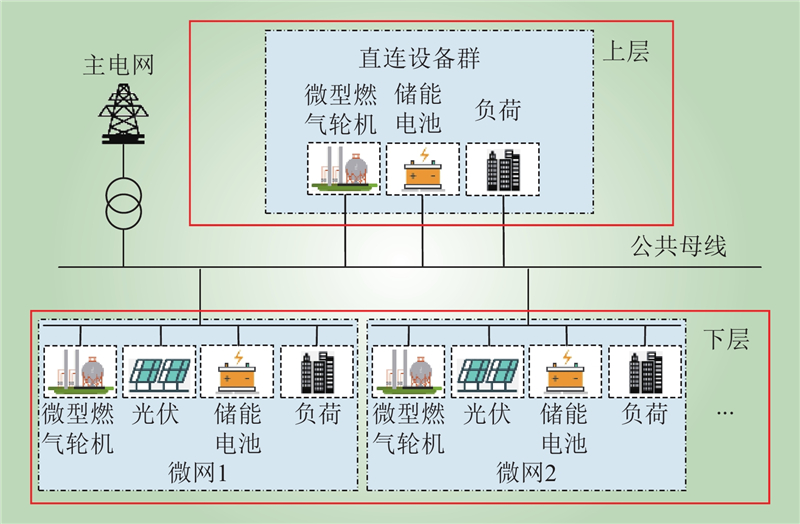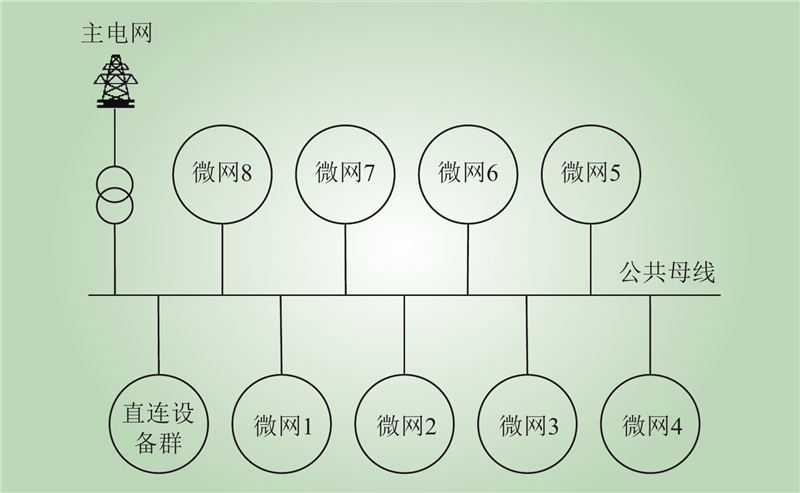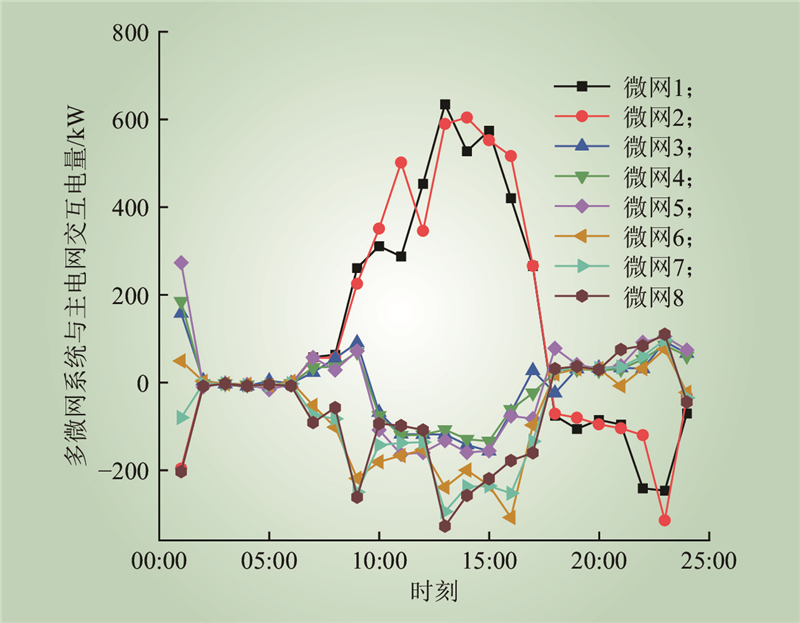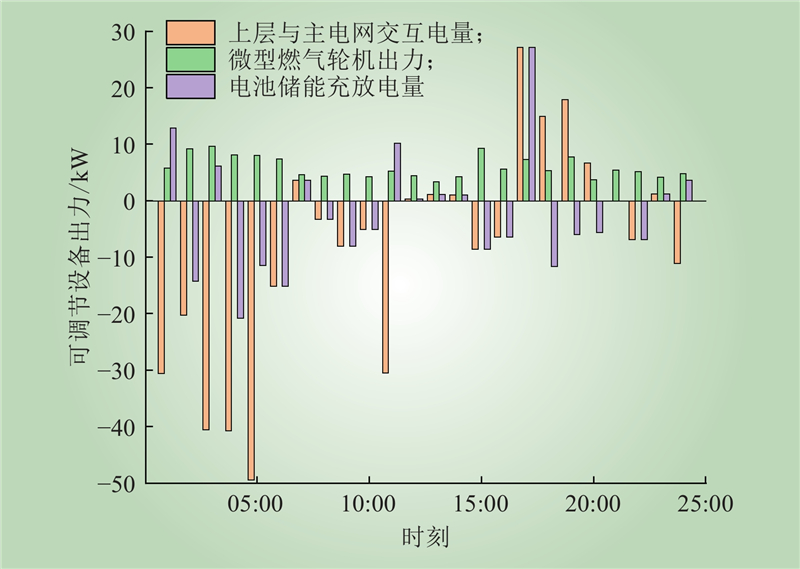| 1 |
刘佳, 唐早, 曾平良, 等. 高比例可再生能源接入下与配电系统分层协同的输电系统自适应规划[J]. 电网技术, 2022, 46 (8): 3105- 3115.
|
|
LIU Jia, TANG Zao, ZENG Pingliang, et al. Adaptive planning of transmission network coordinating distribution networks in a hierarchical manner with high penetration of renewable energy[J]. Power System Technology, 2022, 46 (8): 3105- 3115.
|
| 2 |
刘俊峰, 罗燕, 侯媛媛, 等. 考虑广义储能的微电网主动能量管理优化算法研究[J]. 电网技术, 2023, 47 (1): 245- 255.
|
|
LIU Junfeng, LUO Yan, HOU Yuanyuan, et al. Research on optimization algorithm of active microgrid energy management considering generalized energy storage[J]. Power System Technology, 2023, 47 (1): 245- 255.
|
| 3 |
ZHANG T J, YUE D, YU L A, et al. Joint energy and workload scheduling for fog-assisted multimicrogrid systems: a deep reinforcement learning approach[J]. IEEE Systems Journal, 2023, 17 (1): 164- 175.
DOI
|
| 4 |
黎博, 陈民铀, 钟海旺, 等. 高比例可再生能源新型电力系统长期规划综述[J]. 中国电机工程学报, 2023, 43 (2): 555- 581.
|
|
LI Bo, CHEN Minyou, ZHONG Haiwang, et al. A review of long-term planning of new power systems with large share of renewable energy[J]. Proceedings of the CSEE, 2023, 43 (2): 555- 581.
|
| 5 |
XU D, ZHOU B, CHAN K W, et al. Distributed multienergy coordination of multimicrogrids with biogas-solar-wind renewables[J]. IEEE Transactions on Industrial Informatics, 2019, 15 (6): 3254- 3266.
DOI
|
| 6 |
徐明宇, 郝文波, 王盼宝, 等. 基于动态随机模型的微电网群能量管理方法[J]. 电力工程技术, 2022, 41 (5): 140- 148.
DOI
|
|
XU Mingyu, HAO Wenbo, WANG Panbao, et al. Energy management method of multi-microgrids based on dynamic stochastic model[J]. Electric Power Engineering Technology, 2022, 41 (5): 140- 148.
DOI
|
| 7 |
希望·阿不都瓦依提, 吕海鹏, 晁勤. 基于非合作博弈的风-光-氢微电网容量优化配置[J]. 电力工程技术, 2022, 41 (2): 110- 118.
|
|
XIWANG·Abuduwayiti, LYU Haipeng, CHAO Qin. Optimal capacity configuration of wind-photovoltaic-hydrogen microgrid based on non-cooperative game theory[J]. Electric Power Engineering Technology, 2022, 41 (2): 110- 118.
|
| 8 |
PURAGE M I S L, KRISHNAN A, FOO E Y S, et al. Cooperative bidding-based robust optimal energy management of multimicrogrids[J]. IEEE Transactions on Industrial Informatics, 2020, 16 (9): 5757- 5768.
DOI
|
| 9 |
徐艳春, 刘海权, 孙思涵, 等. 计及需求响应和共享储能的多微网系统双层优化调度[J]. 电力自动化设备, 2023, 43 (6): 18- 26.
|
|
XU Yanchun, LIU Haiquan, SUN Sihan, et al. Bi-level optimal scheduling of multi-microgrid system considering demand response and shared energy storage[J]. Electric Power Automation Equipment, 2023, 43 (6): 18- 26.
|
| 10 |
LU X, XIA S W, SUN G Z, et al. Hierarchical distributed control approach for multiple on-site DERs coordinated operation in microgrid[J]. International Journal of Electrical Power & Energy Systems, 2021, 129, 106864.
|
| 11 |
程奕凌, 张腾飞, 吴巨爱, 等. 基于双层有向图的多微网优化协调运行控制[J]. 电力系统自动化, 2022, 46 (21): 20- 29.
DOI
|
|
CHENG Yiling, ZHANG Tengfei, WU Juai, et al. Optimal coordinated operation control for multi-microgrid based on Bi-level directed graph[J]. Automation of Electric Power Systems, 2022, 46 (21): 20- 29.
DOI
|
| 12 |
陈中, 陈嘉琛, 万玲玲. 基于随机演化动力学的多微网-配电网自组织协同调节策略[J]. 电力系统自动化, 2023, 47 (2): 24- 33.
DOI
|
|
CHEN Zhong, CHEN Jiachen, WAN Lingling. Self-organized cooperative regulation strategy for multi-microgrid-distribution network based on stochastic evolutionary dynamics[J]. Automation of Electric Power Systems, 2023, 47 (2): 24- 33.
DOI
|
| 13 |
华昊辰, 翟家祥, 陈星莺, 等. 基于增强精英保留遗传算法的虚拟多微网系统动态划分及能量局域自治[J]. 中国电机工程学报, 2024, 44 (12): 4652- 4666.
|
|
HUA Haochen, ZHAI Jiaxiang, CHEN Xingying, et al. Dynamical partitioning and local energy autonomy of virtual microgrid groups via strengthen elitist genetic algorithm[J]. Proceedings of the CSEE, 2024, 44 (12): 4652- 4666.
|
| 14 |
KARTHIKEYAN N, PILLAI J R, BAK-JENSEN B, et al. Predictive control of flexible resources for demand response in active distribution networks[J]. IEEE Transactions on Power Systems, 2019, 34 (4): 2957- 2969.
DOI
|
| 15 |
边晓燕, 孙明琦, 许家玉, 等. 计及灵活性储备的含风电多微电网系统分布式协调调控策略[J]. 电力自动化设备, 2021, 41 (8): 47- 54, 104.
|
|
BIAN Xiaoyan, SUN Mingqi, XU Jiayu, et al. Distributed coordinated dispatch and control strategy of multi-microgrid system with wind power considering flexibility reserve[J]. Electric Power Automation Equipment, 2021, 41 (8): 47- 54, 104.
|
| 16 |
MOHAMMADI A, MEHRTASH M, KARGARIAN A. Diagonal quadratic approximation for decentralized collaborative TSO+DSO optimal power flow[J]. IEEE Transactions on Smart Grid, 2019, 10 (3): 2358- 2370.
DOI
|
| 17 |
MAJUMDAR N, SARSTEDT M, KLUB L, et al. Linear optimization based distribution grid flexibility aggregation augmented with OLTC operational flexibilities[J]. IEEE Access, 2022, 10, 77510- 77521.
DOI
|
| 18 |
孙文浩, 张乔, 刘志刚, 等. 考虑高海拔山区铁路沿线电网灵活性的分布鲁棒优化方法研究[J]. 电网技术, 2023, 47 (6): 2485- 2497.
|
|
SUN Wenhao, ZHANG Qiao, LIU Zhigang, et al. A distributionally robust optimization method considering the flexibility of power grid along high altitude mountain railway[J]. Power System Technology, 2023, 47 (6): 2485- 2497.
|
| 19 |
华昊辰, 辛世禹, 陈星莺, 等. 基于“虚拟碳储存”的需求侧电-碳耦合交易机制[J]. 中国电机工程学报, 2024, 44 (6): 2131- 2144.
|
|
HUA Haochen, XIN Shiyu, CHEN Xinying, et al. Demand side electricity-carbon coupling trading mechanism based on "virtual carbon storage"[J]. Proceedings of the CSEE, 2024, 44 (6): 2131- 2144.
|
| 20 |
张志文, 李华强. 考虑灵活性的孤岛微电网群分层能量管理策略[J]. 电力系统保护与控制, 2020, 48 (20): 97- 105.
|
|
ZHANG Zhiwen, LI Huaqiang. A hierarchical energy management strategy for an island microgrid cluster considering flexibility[J]. Power System Protection and Control, 2020, 48 (20): 97- 105.
|
| 21 |
MA Y H, ZHANG M Y, YANG H J, et al. Decentralized and coordinated scheduling model of interconnected multi-microgrid based on virtual energy storage[J]. International Journal of Electrical Power & Energy Systems, 2023, 148, 108990.
|
| 22 |
谢涵铮, 刘友波, 马超, 等. 计及参与成本贡献的用户侧云储能服务及其纳什议价模型[J]. 电力自动化设备, 2024, 44 (2): 9- 17.
|
|
XIE H, LIU Y, MA C, et al. User-side cloud energy storage service considering participation cost contribution and its Nash bargaining model[J]. Electric Power Automation Equipmen, 2024, 44 (2): 9- 17.
|
| 23 |
穆云飞, 唐志鹏, 吴志军, 等. 计及虚拟储能的电-水-热综合能源系统日前优化调度方法[J]. 电力系统自动化, 2023, 47 (24): 11- 21.
|
|
MU Y, TANG Z, WU Z, et al. Optimal day-ahead scheduling method for electricity water hot water integrated energy system considering virtual energy storage[J]. Automation of Electric Power Systems, 2023, 47 (24): 11- 21.
|
| 24 |
WANG R, XIAO G X, WANG P. Hybrid centralized-decentralized (HCD) charging control of electric vehicles[J]. IEEE Transactions on Vehicular Technology, 2017, 66 (8): 6728- 6741.
DOI
|
| 25 |
华昊辰, 李宇童, 王同贺, 等. 一种基于混合随机H2/H∞方法的能源互联网边缘计算系统控制策略[J]. 中国电机工程学报, 2020, 40 (21): 6875- 6885.
|
|
HUA Haochen, LI Yutong, WANG Tonghe, et al. A novel stochastic mixed H2/H∞ control strategy for energy Internet edge computing system[J]. Proceedings of the CSEE, 2020, 40 (21): 6875- 6885.
|
| 26 |
薛溟枫, 毛晓波, 肖浩, 等. 基于联邦学习的综合能源微网群协同优化运行方法[J]. 中国电力, 2023, 56 (12): 164- 173.
|
|
XUE Mingfeng, MAO Xiaobo, XIAO Hao, et al. Cooperative operation optimization for integrated energy microgrid groups based on federated learning[J]. Electric Power, 2023, 56 (12): 164- 173.
|
| 27 |
潘瑞媛, 唐忠, 史晨豪, 等. 基于主从博弈的多主体投资多微网系统优化配置[J]. 中国电力, 2022, 55 (6): 65- 73, 127.
|
|
PAN Ruiyuan, TANG Zhong, SHI Chenhao, et al. Optimal configuration of multi-microgrid system with multi-agent joint investment based on stackelberg game[J]. Electric Power, 2022, 55 (6): 65- 73, 127.
|
| 28 |
李虹, 韩雨萌. 基于LSTM-CGAN的多微网数据驱动分布鲁棒协同优化运行策略[J]. 电力系统保护与控制, 2024, 52 (18): 133- 148.
|
|
LI Hong, HAN Yumeng. Data-driven distributionally robust collaborative optimization operation strategy for a multi-microgrid based on LSTM-CGAN[J]. Power System Protection and Control, 2024, 52 (18): 133- 148.
|
| 29 |
张冲标, 钱辰雯, 俞红燕, 等. 基于ADMM的多场景县域多微电网交互运行策略[J]. 中国电力, 2024, 57 (2): 9- 18.
|
|
ZHANG Chongbiao, QIAN Chenwen, YU Hongyan, et al. Interactive operation strategy for multi-scenario county-level multi-microgrid based on ADMM[J]. Electric Power, 2024, 57 (2): 9- 18.
|
| 30 |
杜佳男, 韩肖清, 李廷钧, 等. 考虑电价不确定性和博弈欺诈行为的多微网电能合作运行优化策略[J]. 电网技术, 2022, 46 (11): 4217- 4230.
|
|
DU Jianan, HAN Xiaoqing, LI Tingjun, et al. Optimization strategy of multi-microgrid electric energy cooperative operation considering electricity price uncertainty and game cheating behaviors[J]. Power System Technology, 2022, 46 (11): 4217- 4230.
|
| 31 |
ZENDEGAN S, FERRARA A, JAKUBEK S, et al. Predictive battery state of charge reference generation using basic route information for optimal energy management of heavy-duty fuel cell vehicles[J]. IEEE Transactions on Vehicular Technology, 2021, 70 (12): 12517- 12528.
DOI
|
| 32 |
张祥宇, 舒一楠, 付媛. 基于虚拟储能的直流微电网源荷储多时间尺度能量优化与分区协调控制[J]. 电工技术学报, 2022, 37 (23): 6011- 6024.
|
|
ZHANG Xiangyu, SHU Yinan, FU Yuan. Multi-time-scale energy optimization and zone coordinated control of DC microgrid source-load-storage based on virtual energy storage[J]. Transactions of China Electrotechnical Society, 2022, 37 (23): 6011- 6024.
|
| 33 |
LEE H, KIM N W, LEE J G, et al. Error distribution-based anomaly score for forecasting-based anomaly detection of PV systems[C]//2021 International Conference on Information and Communication Technology Convergence (ICTC). Jeju Island, Korea. IEEE, 2021.
|
| 34 |
BROWELL J, FASIOLO M. Probabilistic forecasting of regional net-load with conditional extremes and gridded NWP[J]. IEEE Transactions on Smart Grid, 2021, 12 (6): 5011- 5019.
DOI
|
| 35 |
KIM J H, LEE J, JOO S K. Conditional value-at-risk-based method for evaluating the economic risk of superconducting fault current limiter installation[J]. IEEE Transactions on Applied Superconductivity, 2015, 25 (3): 1- 4.
|
| 36 |
DENG X C, WANG F, LIN X K, et al. Distributed energy management of home-vehicle Nexus with stationary battery energy storage[J]. Renewable and Sustainable Energy Reviews, 2022, 168, 112837.
DOI
|
| 37 |
宋瑞, 王依冉, 吴中明. 非精确广义不定邻近交替方向乘子法的收敛性分析[J/OL]. 运筹学学报: 1–17[2023-11-07]. http://kns.cnki.net/kcms/detail/31.1732.O1.20230608.1046.034.html.
|
|
SONG Rui, WANG Yiran, WU Zhongming. convergence analysis of the inexact generalized alternating direction method of multipliers with indefinite proximal term[J/OL]. Operations Research Transactions: 1–17[2023-07-13]. http://kns.cnki.net/kcms/detail/31.1732.O1.20230608.1046.034.html.
|
| 38 |
Pecan Street Inc. Dataport (data_california) [DB/OL]. ( 2020-12-31) [2023-02-10]. https://dataport.cloud/.
|






